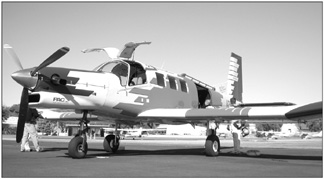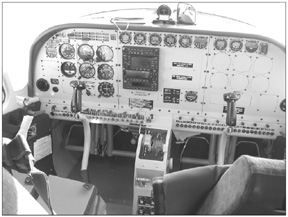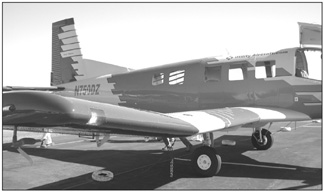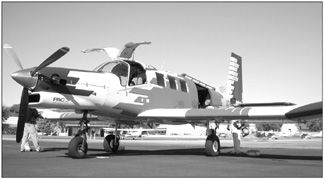
by Paul Bertorelli
The term utility aircraft is, at best, a misnomer and at worst, misguided. Models such as Cessnas 185 and 206 are considered utility airplanes but only because they happen to haul heavy loads. A Cherokee Six fits into the category for the same reason; it wasnt designed to be an all-purpose cargo airplane but muddles along in that role.
If utility means work, then true utility airplanes are purpose-built for some focused range of tasks, say, ag application or banner towing or hauling heavy stuff, with no thought of amenities for passengers. Cessnas Caravan is one example and there are cargo variants of the Pilatus PC-12. Muscling into this narrow market comes one of the most unusual airplanes weve seen in a long time: the Pacific Aerospace Corp. 750XL, or PAC750XL for short. If biological evolution were in charge of airplane design, the 750XL would cap the evolutionary line that began with Jurassic birds carting off twice their weight in live dinosaurs. The 750XL wont quite carry that much, but its one of those rare airplanes that can carry its own empty weight in cargo.
A Familiar Shape
Although the 750XL is like nothing most of us have ever seen, its also…familiar. Where have we seen those poly-dihedral wings before? On the Thorp T-18, for one, a popular homebuilt of the 1960s that was one of the first high-performance experimentals and pioneered the use of stabilators for pitch control. No surprise that designer John Thorp-who died in 1992-is responsible for the predecessor of the 750XL, an airplane called the Fletcher.
In 1953, Thorp was working for a California manufacturer called Fletcher Aviation Corp. and was assigned to develop a light ground attack airplane, the FD25 Defender. That project evolved into something more practical, an ag airplane called the FU24. Those aircraft were marketed in New Zealand and were eventually manufactured there as well, by what became Pacific Aerospace.The original Fletcher, as these airplanes are known, had a 225-HP Continental engine but many have since been refitted with larger engines, including up to a 500-HP Pratt & Whitney PT6.
In 1975, PAC developed a more powerful airplane from the basic Fletcher, which was called the Cresco, Latin for I grow. ( You surely remember that from high school Latin.) The Cresco originally had a Lycoming LTP 101 turbine but in 1992, a version of it using Pratts 750-HP PT6A-34 appeared. That airplane formed the basis of what became the 750XL, which is yet a larger airframe.
Although the 750XLs richest market will certainly be in ag or cargo operations, its launch market is unorthodox: the skydiving aircraft market.Although the skydiving industry uses a mix of piston singles and turbine twins, turbine singles-Cessnas Caravan, mainly-have increasingly proved attractive because they climb nearly as fast as a twin on half the fuel.Further, freight and utility operators say the Caravan has excellent dispatch reliability and is relatively cheap to maintain.
The same cant be said of the older King Airs that find their way into freight or skydiving service only because theyre cheap to buy. Mid-1960s King Air 90s sell for as little as $200,000. Some turbine operators buy them merely to scavenge the engine cores. PACs marketing strategy is to concede the higher price for a new airplane with the promise of offsetting it by lowering operating costs. For operators willing to take on debt load, argues PAC, the 750XLs lower operating costs will more than offset the bank note.
Were inclined to believe that the 750XL wont find much market among private owners but we thought the same thing about the Caravan. Yet the Caravan is flown by some private operators, especially those who use it for dual business/personal use. Were not sure if the 750XL will have the same appeal, but we think it will have to be both IFR and known-ice certified first. Both of those approvals are pending. For now, the 750XL is a VFR-only airplane.
This Thing Is Huge
We were shown the 750XLs ropes by Ray Ferrell, a principal in Utility Aircraft Corp., the company thats importing the airplane from New Zealand and supporting it. Ferrell has been operating a 750XL for about 10 months at his commercial skydiving operation in Davis, California. The 750XL we flew was equipped typically, which is to say not lavishly but not Spartan, either.Even though not approved for IFR, the panel was we’ll enough equipped for IMC.
For pilots accustomed to general aviation low-wing aircraft, the PAC750XL looks remotely like a pumped-up Piper Saratoga, until you get close to it.Its an enormous airplane, with chest-high wings perched atop three tall fixed-gear legs. Like John Thorps other designs, the wings are relatively short but have a long, constant chord, which portends benign slow speed handling. Like the Caravan, everything on the airplane is high off the ground; examining the engine is a tree climb, as is getting into the thing through the rear cargo door.
In plan view, the airplane looks much like the typical Piper product, with squarish wings tapered out at the root/fuselage intersection. Unlike other Thorp designs, the airplane doesnt have a stabilator but a conventional horizontal stab and elevator with anti-servo trim-both electric and manual-and giant, beefy ailerons positioned on the upturned portion of the wings.Speaking of which, whats the deal with those wings? Does the poly-dihedral offer some kind of magical aerodynamic or structural advantage? No and yes.Actually, the wing is not dual dihedral at all; the center or inner portion of the span is flat and the upturned ends provide all of the wings dihedral so, in composite, the wing has the same total dihedral as any typical aircraft.
The advantages of this design, says Richard Eklund, the current caretaker of drawings for the T-18, is primarily simplicity of construction. Thorp devised a simple, continuous spar flat along its length and pinned inside the fuselage to transfer loads.
The spar was easy to build for homebuilders and whats true for homebuilders is true for airplane factories. Any aerodynamic gains or losses of the upturned wing design are minimal. We did note that the airplane is exceptionally stable in roll, especially in ground effect during landings.
There’s nothing delicate about the wing section, either. Its slab thick, providing generous lift for the rocket-like climbs the 750XL is capable of.But where there’s high lift, there’s also drag and despite its 750 HP, the 750XL is not a fast airplane. Cruise speeds in the low 160-knot range are typical.

Fit It, Haul It
Airplanes that haul a lot are sometimes saddled with the clich that if you can close the doors on the load, you can haul it. Its rarely true, but its probably more true of the 750XL than of any type weve reviewed. Gross weight of the airplane is 7500 pounds with a claimed typical empty weight of about 3100 pounds. That leaves an astonishing 4400 pounds of useful load. Even if you knock off 400 pounds for all the extras you can think of, thats two tons of useful load. With full fuel-227 gallons-the airplane will carry nearly 2900 pounds. But utility airplanes are rarely flown fully fueled, so load capability in the real world is greater than that. With the airplane down fueled, commercial skydiving operations can expect to carry 17 jumpers with turns to altitude in 13 to 15 minutes. That compares favorably to twin turbines but on half the fuel burn.
For cargo operations, the cabin measures 13 feet long by 4 1/2 feet wide and tall; you can stand up in a crouch. The door measures 48 inches by 47 inches high, tapering to 42 inches at its narrowest toward the rear of the airplane. It has a slide-up door but may be configured with other door designs to suit cargo operators.
The airplane can also be fitted with a belly-mounted cargo pod, which suggests that PAC rightly foresees it finding application in the passenger/freight market, or in that segment of the cargo market where the load bulks out the airplanes volume without reaching gross weight limits. (Think FedEx and UPS.) Operators will like the fact that the cabin can be stuffed with cargo and the pilot can still enter the airplane through the individual cockpit doors.
Rugged Systems
PAC has adhered to John Thorps philosophy of rugged, simple-to-build airplanes with rudimentary systems. In an era where every new airplane is fitted with a glass panel, the 750XL remains a practical throwback with a no-frills, steam-gauge panel. The model we flew had a basic six-pack instrument package-with a DG, not an HSI-and a Garmin GNS430 as a primary navigator, with a GNC250XL in the second slot. All of the engine instrumentation-torque, fuel monitoring, RPM, ITT and so on-is presented in a single row of Electronic International digital LCD instruments along the top of the panel.There’s room enough for a full set of co-pilot instruments, although the model we flew didnt have them.
A pair of honking big center sticks dominate the cockpit and each is equipped with a coolie hat trim button for both pitch and roll trim. There’s a manually operated rudder trim control on an overhead panel, reminiscent of older Pipers. Control circuitry is a combination of tubes and cables for the ailerons and elevator and there’s a bungee interconnect between the ailerons and rudder.
The 750XL has electrically controlled slotted flaps which extend the length of the flat wing section, controlled by a detent switch on the pedestal. Intended as it is for rough field work, the landing gear is typical of a Cherokee, only longer and with longer-stroke oleos; it should be simple to maintain.
For power, PAC chose a variant of the venerable Pratt & Whitney PT6A, the dash 34. Its equipped with a simplified, near-automatic starting system and has Beta range for stopping on the ground.
The fuel is carried in four tanks, a forward and aft cell in each wing, each with its own filler. The forward tanks are filled first, then the aft, and an immersed transfer pump in each tank moves fuel forward as its burned out of the front tanks.
Flying It
Apart from starting and operating a turbine engine, any competent Saratoga driver would have no trouble flying the 750XL. Despite its size, it handles easily on the ground and taxi visibility is excellent from the high perch.Applying power for takeoff requires a deft touch, as with most turbines. Advance the throttle in a too-quick thrust and there’s a brief delay, then 750 horses thunder forward all at once. Similarly, in the air, power has to be rolled on about two seconds before its needed.
As turbines go, starting the -34 in the 750XL is simple. There’s a momentary starter switch that automatically engages the starter; once RPM reaches 12 percent Ng, the fuel condition lever is moved to ground idle.Thats it. The pilot need merely monitor the ITT for signs of a hot start.
Power application for takeoff is easily learned in a couple of tries, but what we found difficult to adjust to is the airplanes initial climb rate: at light to moderate weights, its startling. We noted nearly 3000 FPM initially, with less than half fuel and two people aboard.
With 11 skydivers loaded-more than 2000 pounds-the airplane still climbed at 2200 FPM initially. It took nine minutes to reach 13,500 feet for an average rate of 1500 FPM. Initially, the deck angle feels alarmingly high for such climbs but the nose can be lowered for better visibility without giving up much rate.
The view out the windows-side and forward-is excellent but we think the airplane could benefit from eyebrow windows in the crew doors; the upward view is somewhat restricted. Obtaining level flight visually requires pointing the nose lower than seems natural due to the longish nose and the fact that the sills on the crew doors angle downward toward the front of the airplane.
Although fast cruise is not the 750XLs forte, its respectably fast. At 10,000 feet, we calculated 167 knots TAS at 380 pounds per hour or about 57 GPH. That would yield three hours of endurance with reserves and a still air range of 500 miles. For another 100 miles of range, a more efficient cruise speed is about 150 knots at 300 PPH/45 GPH.
With its considerable power and fat wing, the 750XL is an exceptional short field performer, both in takeoff and landing. Approaches are flown at light aircraft speeds-75 knots at higher weights-with a conventional touchdown on the mains. For max effort landings, Beta application stops the airplane in a few hundred feet. Otherwise, a short Beta blast is enough to ease strain on the brakes.

Conclusion
The freight/utility field is a game of numbers, where success is defined by shoehorning enough revenue-generating stuff into an airplane and flying it less expensively than the competition. In a turbine, less expensive means lower purchase and operating costs. In both regards, the 750XL looks promising on paper when compared to a new Cessna Caravan or an older used turbine twin, say a King Air or a Twin Otter.
At a purchase price of $1.1 million, the 750XL costs less than a new Caravan at $1.4 million and up, carries more than the basic Caravan and about the same as the Super Cargomaster version, but it climbs faster. On the other hand, a decent used 1980s Cargomaster sells for $750,000, which may make a new 750XL purchase-or any new airframe-less compelling. Whether it makes sense to financially leverage a new airplane rather than buy used depends on the revenue the intended business can generate.
In our view, the 750XL looks like a contender and we think PAC has an opportunity but also some work ahead of it. The airplane needs to be certified for IFR-which it should be shortly-and for known-ice to compete in all aspects of the freight market. With the Caravan encountering some problems with its performance in icing-there have been 26 icing-related crashes-the market may be looking for something better.
Second, PAC and Utility Aircraft will need to continue building a support and service network to be at least as capable as Cessnas. Nothing spooks buyers more than purchasing an expensive imported airplane with a parts supply chain half a world away.
Contact – Utility Aircraft Corp., 530-750-3226, www.utilityaircraft.com.
Also With This Article
“Checklist”





